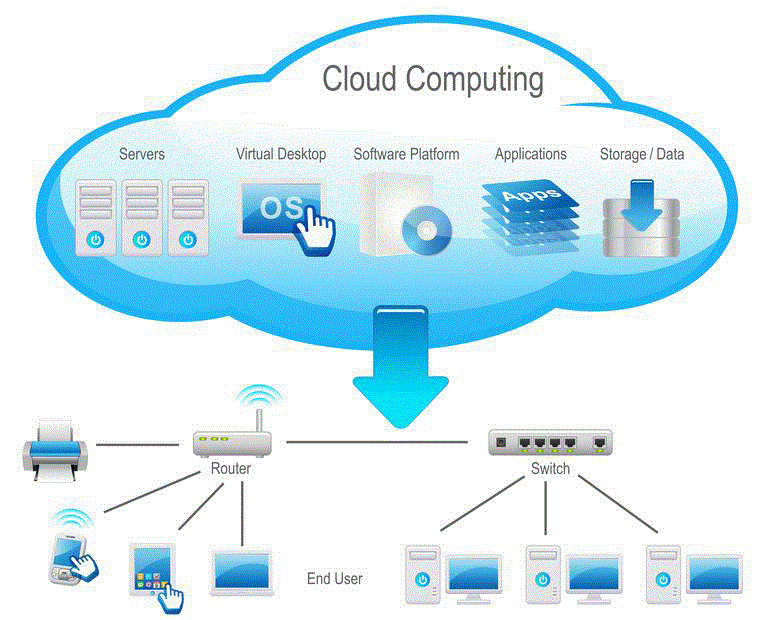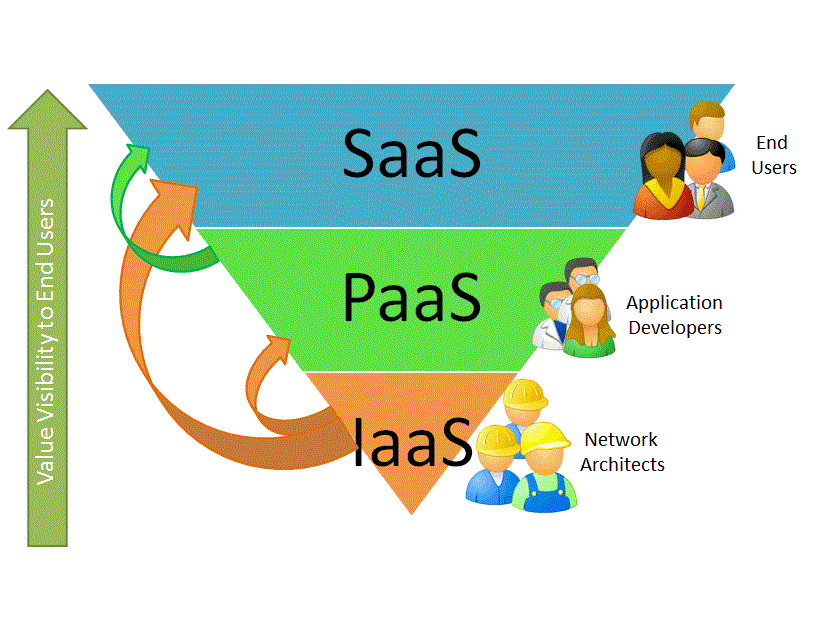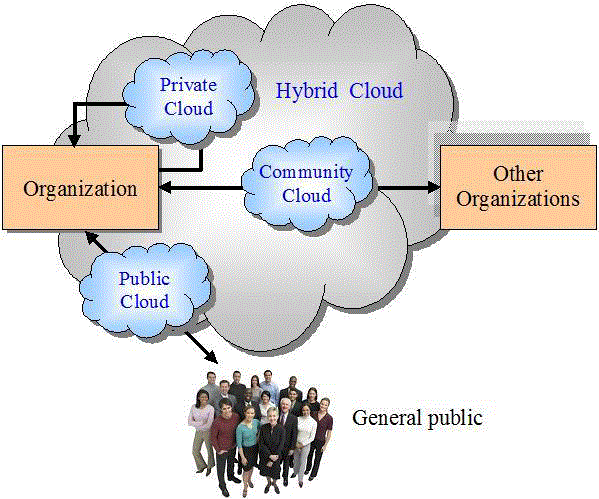Keywords
|
| Cloud computing,Deployment model.RAS,Service Model. |
INTRODUCTION
|
| Cloud computing is a technology that uses the internet and central remote servers to maintain data and applications. Cloud computing allows consumers and businesses to use applications without installation and access their personal files at any computer with internet access. This technology allows for much more efficient computing by centralizing storage, memory, processing and bandwidth. Cloud computing is a comprehensive solution that delivers IT as a service. |
| Cloud computing service models: There are three fundamental Service models in Cloud computing. Three service models are presented below. |
| 1 Software as a Service:Cloud Applications or Software as a Service (SaaS) refers to software delivered over a browser. SaaS eliminates the need to install and run applications on the customer's own computers/servers and simplifies maintenance, upgrades and support. Examples of SaaS are Facebook, SalesForce, etc. The Cloud Computing service model is given in figure 2. |
| 2. Platform as a Service: Cloud platform services or Platform as a Service (PaaS) refers to an environment for software development, storage and hosting delivered as-a-service over the Internet. Examples of PaaS are Google App Engine, Force.com, Microsoft Azure, WOLF, etc. |
| 3. Infrastructure as a Service: Cloud infrastructure services or Infrastructure as a Service (IaaS) delivers a computing infrastructure, typically a virtualization environment, as-a-service. Examples of IaaS are virtual servers leased by Amazon, Rackspace, GoGrid, etc. |
| Deployment model |
| Cloud Computing Deployment model is given in figure 3.. |
| Each company chooses a deployment model for a cloud computing solution based on their specific business, operational, and technical requirements. Four primary cloud deployment models are private cloud, community cloud, public cloud, and hybrid cloud. |
| Public Cloud: Public cloud refers to Cloud Computing in the traditional mainstream sense, whereby resources are dynamically provisioned on a fine-grained, self-service basis over the Internet. These resources are provisioned via web applications/web services, from an off-site third-party provider who shares resources and bills the customer on a fine-grained utility computing basis. |
| Community Cloud: A community cloud is established among several organizations that have similar requirements and seek to share their computing infrastructure in order to realize some of the benefits of the Public Cloud. |
| Private Cloud: A term that is similar to, and derived from, the concept of Virtual Private Network (VPN), is applied to Cloud Computing. The Private Cloud delivers the benefits of Cloud Computing with the option to optimize on data security, corporate governance and reliability. |
| Hybrid cloud: The cloud infrastructure is shared by several organizations with common concerns (eg, mission, security requirements, policy, and compliance considerations). |
II.EXISTING SYSTEM
|
| The cloud, the group members can be completely released from the troublesome local data storage and maintenance. It also poses a significant risk to the confidentiality of those stored files.First, identity privacy is one of the most significant obstacles for the wide deployment of cloud computing. Traceability, which enables the group manager (e.g., a company manager) to reveal the real identity of a user, is also highly desirable. |
| Second, it is highly recommended that any member in a group should be able to fully enjoy the data storing and sharing services provided by the cloud, which is defined as the multiple-owner manner. Compared with the singleowner manner, where only the group manager can store and modify data in the cloud, the multiple-owner manner is more flexible in practical applications. More concretely, each user in the group is able to not only read data, but also modify his/ her part of data in the entire data file shared by the company. |
| ISSUES IN EXISTING SYSTEM: The cloud servers managed by cloud providers are not fully trusted by users while the data files stored in the cloud may be sensitive and confidential, such as business plans. To preserve data privacy, a basic solution is to encrypt data files, and then upload the encrypted data into the cloud. Unfortunately, designing an efficient and secure data sharing scheme for groups in the cloud is not an easy task. |
III. RESOURCE ALLOCATION STRATEGIES
|
| Resource allocation is process of assigning the available resources in an economic way and efficient and effective way Resource allocation is the scheduling of the available resources and available activities required by those activities while taking into consideration both the resource availability and the project time. Resource provisioning and allocation solves that problem by allowing the service providers to manage the resources for each individual request of resource. Resource Allocation Strategy (RAS) is all about the number of activities for allocating and utilizing inadequate resources within the limit of cloud environment so as to meet the needs of the cloud application. It requires the type and amount of resources needed by each application in order to complete a user job |
| From the perspective of a cloud provider, predicting the dynamic nature of users, user demands, and application demands are impractical. For the cloud users, the number of tasks of job needs to be completed on time with minimal cost. Hence due to limited resources, resource heterogeneity, environmental necessities, locality restrictions and dynamic nature of resource demand, we need an efficient resource allocation system that suits cloud environments. Cloud resources consist of virtual resources. The physical resources are shared across multiple computer quests through virtualization and provisioning. The virtualized resources are described through a set of parameters detailing the processing, memory and disk needs. Provisioning of cloud can be done by mapping virtualized resources to physical ones. The software and hardware resources are allocated to the cloud applications on-demand basis [1]. |
IV.ADVANTAGES AND LIMITATIONS OF RESOURCE ALLOCATION STRATEGIES
|
Advantages:
|
| • The first major benefit of resource allocation is that user neither has to install software nor hardware to access the applications, to develop the application and to host the application over the internet. |
| • The next major benefit is that there is no limitation of place and medium. We can reach our applications and data anywhere in the world, on any system. |
| • The user does not need to expend on hardware and software systems. |
| • Cloud providers can share their resources over the internet during resource scarcity. |
Limitations:
|
| • Since users rent resources from remote servers for their purpose, they don’t have control over their resources. |
| • Migration problem occurs, when the users wants to switch to some other provider for the better storage of their data. It’s not easy to transfer huge data from one provider to the other. |
| • In public cloud, the clients’ data can be susceptible to hacking or phishing attacks. Since the servers on cloud are interconnected, it is easy for malware to spread. |
| • Peripheral devices like printers or scanners might not work with cloud. Many of them require software to be installed locally. Networked peripherals have lesser problems. |
| • More and deeper knowledge is required for allocating and managing resources in cloud, since all knowledge about the working of the cloud mainly depends upon the cloud service provider. |
V. SUMMARY OF RESOURCE ALLOCATION STRATEGIS
|
| A.Meera and S.Swamynathan proposed an approach for allocating resources based on the analyzed data that is being analyzed by a monitoring agent. The monitoring agent will collect the resources usage information that is currently being used by a virtual machine and will display it in a dashboard. Statistical report that is being displayed on a dashboard provides an information for cloud administrator for better optimization of resources. At this point this approach suffers from the centralized coordination because agents are not autonomous so future work can be focused on autonomous agents.Kyle Chard, Simon Caton, Kris Bubendorfer, Omer Rana proposed an approach of a social cloud for sharing the resources on the base of relationship, trust and risk, and policies with the coordination of social market. A Social cloud is resource and service sharing framework utilizing relationships established between members of a social network. Social market is being used in order to regulate the resource sharing within the group. K C Gouda, Radhika T V, and Akshatha M proposed a priority based resource allocation approach with minimum wastage and a maximum profit. Priority is being considered in terms of different parameters like time, cost, number of processor requests etc. priority can be used for better resource allocation in cloud environment. |
| Diptangshu Pandit, Matangini Chattopadhyay, and Nabendu Chaki proposed an efficient resource allocation algorithm with the use of simulated annealing. In this approach authors had introduced the concept of bin, soft computing and simulated annealing. In this approach, problem of resource allocation is being solved with the help of bin packing problem. In this approach temperature is being considered as a control parameter but no formal procedure of selecting the temperature has been described in this approach. |
CONCLUSION
|
| Cloud computing technology is increasingly being used in enterprises and business global markets. A evaluate shows that dynamic resource allocation is growing need of cloud providers for more number of users and with the less response time. In cloud paradigm, an effective resource allocation strategy is required for achieving user satisfaction and maximizing the profit for cloud service providers. This paper summarizes the main resource allocation strategies and its impacts in cloud system. Some of the strategies discussed above mainly focus on memory resources but are lacking in other factors. Hence this survey paper will hopefully motivate future researchers to come up with smarter and secured optimal resource allocation algorithms and framework to strengthen the cloud computing paradigm. |
Figures at a glance
|
 |
 |
 |
| Figure 1 |
Figure 2 |
Figure 3 |
|
References
|
- V. Vinothina, Dr. R. Shridaran, and Dr. PadmavathiGanpathi, A survey on resource allocation strategies in cloud computing, InternationalJournal of Advanced Computer Science and Applications, 3(6):97--104, 2012.
- Gunho Lee, NirajTolia, ParthasarathyRanganathan, and Randy H. Katz, Topology aware resorce allocation for data-intensive workloads,ACM SIGCOMM Computer Communication Review, 41(1):120--124, 2011.
- Abirami S.P. and ShaliniRamanathan, Linear scheduling strategy for resource allocation in cloud environment, International Journal onCloud Computing: Services and Architecture(IJCCSA), 2(1):9--17, 2012.
- Chandrashekhar S. Pawar and R.B. Wagh, A review of resource allocation policies in cloud computing, World Journal of Science andTechnology, 2(3):165-167, 2012.
- A.Meera, S.Swamynathan, “Agent based Resource Monitoring system in IaaS Cloud Environment”, International Conference onComputational Intelligence: Modeling Techniques and Applications (CIMTA), 2013
- Weiwei Lin, James Z. Wang, Chen Liang, and Deyu Qi, “A Threshold-based Dynamic Resource Allocation Scheme for Cloud Computing”,Procedia Engineering volume 23, 2011, Pages 695–703
- K C Gouda, Radhika T V, Akshatha M, “Priority based resource allocation model for cloud computing”, International Journal of Science,Engineering and Technology Research (IJSETR) Volume 2, Issue 1, January 2013
- EwnetuBayuhLakew, Francisco Hernandez-Rodriguez, Lei Xu and Erik Elmroth, “Management of Distributed Resource Allocations inMulti-cluster Environments”, Performance Computing and Communications Conference (IPCCC), IEEE 31st International, 2012
- DiptangshuPandit, MatanginiChattopadhyay, and NabenduChaki, “Resource Allocation in Cloud using Simulated Annealing”, Applicationsand Innovations in Mobile Computing (AIMoC), Feb. 27 2014 –March 1 2014, Pages 21-27
|